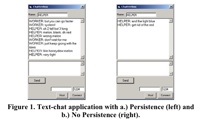D. Gergle, D. R. Millen, R. E. Kraut, and S. R. Fussell. Persistance matters: Making the most of chat in tightly-coupled work. In Proceeding of CHI2004, pages 431–438, Vienna, Austria, April 24-29 2004. ACM Press. [pdf]
————-
This paper present a controlled experiment to asses the effect of the history of conversation on task performances. The study shows how the history of the conversation has an impact on computer-mediated communication tasks that require semantic coordination to disambiguate utterances.
The author used a puzzle task where an “helper” has to guide the “worker” to solve the puzzle. In their experimental setup the author controlled wether the helper could see the space of interaction of the worker and can refer to the objects by the mean of deictic expressions. The shared visual space is a resource for grounding that makes the conversation more efficient.
The results demonstrate the importance of two resources for conversational grounding: a persistent dialogue history and a shared visual space.
How much history of the dialogue should a chat client include? Some chat clients have minimized the dialogue history to deploy the space for other purposes. A theory of conversational coordination suggests that stripping away history raises the cost of conversational grounding, creating problems for both writers and readers. To test this proposition and inform design, we conducted an experiment in which one person instructed another on how to solve a simple puzzle. Participants had chat clients that showed either a single conversational turn or six of them. Having the dialogue history helped collaborators communicate efficiently and led to faster and better task performance. The dialogue history was most useful when the puzzles were more linguistically complex and when instructors could not see the work area. We present evidence of participants adapting their discourse to partially compensate for deficits in the communication media.
![]() Tags: collaboration tools, Computer Supported Collaborative Work, human computer interaction, interaction design, user experience
Tags: collaboration tools, Computer Supported Collaborative Work, human computer interaction, interaction design, user experience


